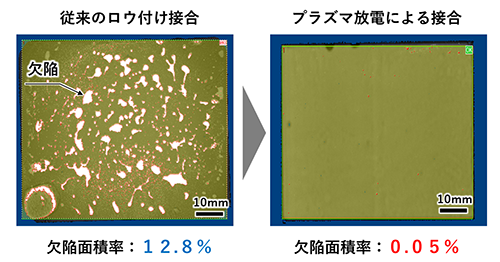

Toho Metals: Dissimilar metal bonding with plasma: High quality, power consumption 1/3 or less
National Institute for Fusion Science, Toho Kinzoku
The research group has newly developed a dissimilar metal bonding technology using plasma.
Tungsten, which has a high melting point,
Copper alloy with high thermal conductivity, etc.
A metal with completely different properties
Succeeded in high quality joining.
Development of new technology:
The new technology that was successfully developed this time is “a product that was born in the process of development and research for future fusion reactors.”
In the future, we will contribute to improving the performance of parts used in transportation and construction equipment and power transmission equipment that supports social infrastructure.
reaserch result :
We have developed a new dissimilar metal bonding technology (powder solid phase bonding method) using plasma.
Powder solid phase bonding method:
With this new technology, we have solved the problems of using the conventional brazing method and succeeded in joining high-quality W and Cu.
Features of this technology:
The points of this technology are the following three points (Fig. 1).
① Gap between materials: “Plasma discharge”
A large current is passed while pressing the bonding materials against each other with a strong force.
Then, a small lightning called “plasma discharge” is generated in the gap between the materials.
The place where this lightning struck partially melts and sticks.
However, if there is even a small amount of oxygen in this bonding process, W will oxidize and poor bonding will occur.
② Suppress the formation of oxides
Therefore, hydrogen, which has a strong antioxidant effect, is used to suppress the formation of oxides.
③ Install the intermediate layer: W and Cu powder are mixed
In order to alleviate the difference in thermal expansion between W and Cu, an intermediate layer in which W and Cu powder is uniformly mixed is installed.
With this kind of device, defects that occur near the joint surface are extremely reduced (Fig. 2).
We have succeeded in high-strength, high-quality bonding of W and Cu by effectively suppressing the occurrence of cracks.
Significance of results and future development:
Compared to the brazing method, this technology does not require skilled skills in the joining process.
The defect rate is low, and the joint is completed in a short time (several minutes to 1 hour).
Other joining techniques:
In addition, the power consumption is about 1/3 to 1/5 compared to other joining technologies currently under research (pressure sintering method * 1, hot isostatic pressing method * 2), etc. It saves energy and reduces the burden on the environment.
National Institute for Fusion Science
https://www.nifs.ac.jp/press/200918.html
Development of advanced high heat flux and plasma-facing materials
Ch.Linsmeier1, M. Rieth2, J. Aktaa2, T. Chikada3, A. Hoffmann4, J. Hoffmann2, A. Houben1, H. Kurishita5, X. Jin2, M. Li6Show full author list
Published 9 June 2017 • © 2017 Forschungszentrum Jülich GmbH
Abstract
Plasma-facing materials and components in a fusion reactor are the interface between the plasma and the material part.
The operational conditions in this environment are probably the most challenging parameters for any material: high power loads and large particle and neutron fluxes are simultaneously impinging at their surfaces.
To realize fusion in a tokamak or stellarator reactor, given the proven geometries and technological solutions, requires an improvement of the thermo-mechanical capabilities of currently available materials.
IOPscience